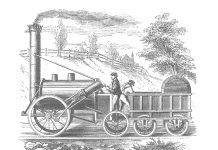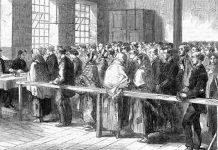A new book by author Angela Buckley explores the life of Manchester’s most famous Victorian Detective. About Manchester talks to the author.
Angela Buckley was drawn to the story of Manchester’s most famous detective Jerome Caminada, in part by her own family history, her ancestors having settled in Ancoats from Italy in the mid nineteenth century.Later she would discover that another relative had run a brothel in the area on the same beat as Caminada and was intrigued by the distinct possibility that they would have known each other.
He had had a terribly difficult childhood. His father had died when the young Jerome was just three years old and he was one of four survivors from eight children.
The family moved around Manchester frequently, finally settling on Byrom street, around modern day Spinningfields.It was here in the back streets of industrial city that a young Caminada would learn the ways of the Manchester underworld, skills that would help him in his future career and solve one of his most famous cases.
He did some time in the military and worked at a Salford Iron works but a deep sense of social justice along with his strong Catholic faith would propel him into the city’s police force at the age of twenty three.
He rose through the ranks quickly for someone from a lowly rank. He showed an early aptitude for detective work, and was promoted into the detective department and would become one of Manchester’s most famous and respected detectives.
His most notorious case came in 1889 when John Fletcher, a well-respected businessman hailed a cab on the steps of Manchester Cathedral with a young man.An hour later, the cabman found Fletcher and his companion vanished. initially medical staff believe he had died of alcohol poisoning but Camadina had a hunch this was murder, and using his knowledge of the underworld, managed to link the murder with the theft of cyanide from Liverpool. He quickly connected it to Charlie Parton, son of a beerhouse keeper, and two other crimes where people had been drugged and robbed. He then located two witnesses , one who had seen Parton pouring liquid from a vial into Fletcher’s beer on the night of his death.
Just three weeks after the crime, eighteen year old Charlie Parton was arrested and convicted of the murder of John Fletcher.His death sentence was later commuted to life imprisonment.
Caminada retired from the force in 1900 but would leave behind tales of his exploits which resonate today. Hiding in a piano box in the Free Trade Hall to identify the thief of sheet music, catching a magistrate in the act of exposing himself to a factory boy and infiltrating a cross dressing ball by using the password, ‘Sister!’
Was he then the inspiration for Conan Doyle’s Sherlock Holmes? Angela tells me that we simply don’t know.There is little doubt his fame had spread to London but there is no documentary evidence that the author used his story for his character.
Jerome wrote his memories after his retirement. He comes across as being very outspoken, he had uncovered corruption in the force and had what we would regard today as liberal views on the penal system and the use of corporal punishment.
More information about the Victorian Super-sleuth can be found HERE
Angela is talking about the book at this week’s Manchester Histories Festival








